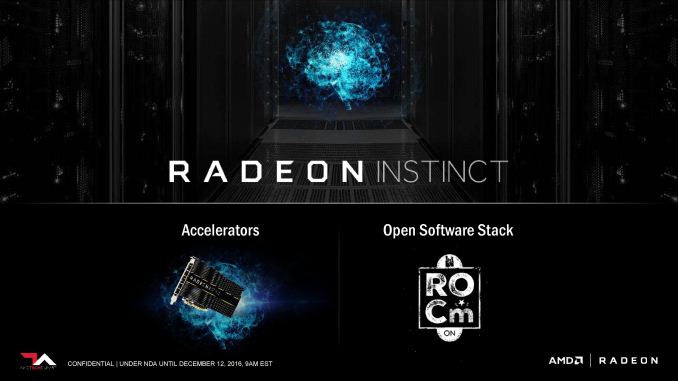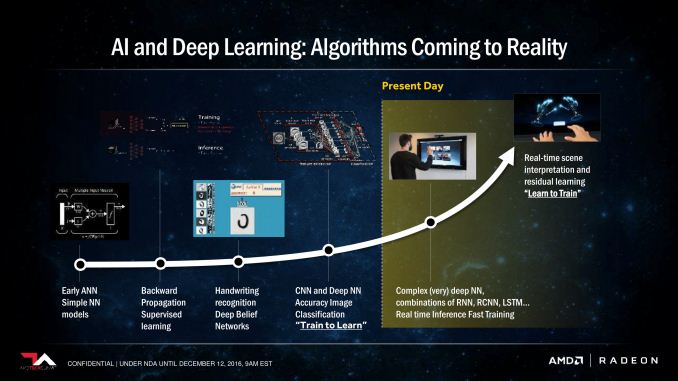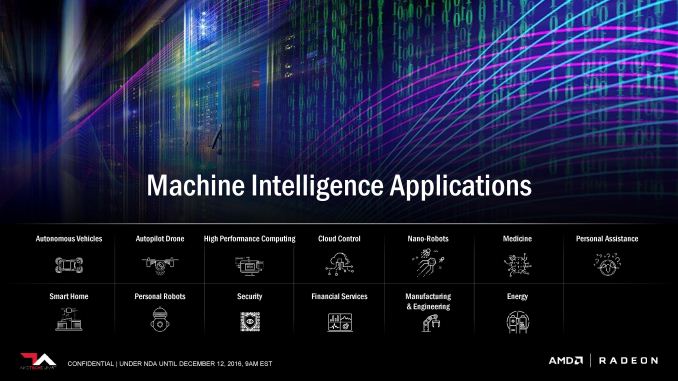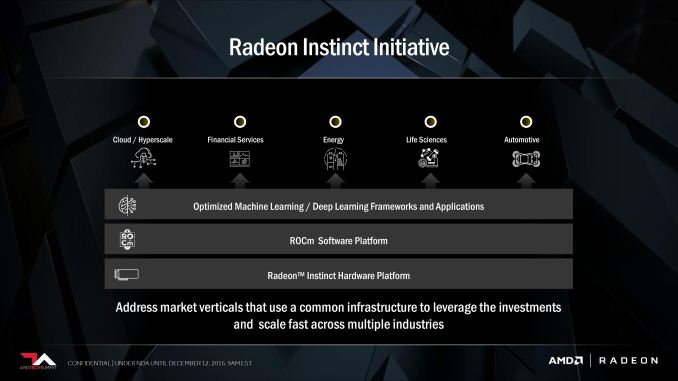AMD Announces Radeon Instinct: GPU Accelerators for Deep Learning, Coming In 2017
by Ryan Smith on December 12, 2016 9:00 AM EST- Posted in
- GPUs
- AMD
- Radeon
- Fiji
- Machine Learning
- Polaris
- Vega
- Neural Networks
- AMD Instinct

With the launch of their Polaris family of GPUs earlier this year, much of AMD’s public focus in this space has been on the consumer side of matters. However now with the consumer launch behind them, AMD’s attention has been freed to focus on what comes next for their GPU families both present and future, and that is on the high-performance computing market. To that end, today AMD is taking the wraps off of their latest combined hardware and software initiative for the server market: Radeon Instinct. Aimed directly at the young-but-quickly-growing deep learning/machine learning/neural networking market, AMD is looking to grab a significant piece of what is potentially a very large and profitable market for the GPU vendors.
Broadly speaking, while the market for HPC GPU products has been slower to evolve than first anticipated, it has at last started to arrive in the last couple of years. Early efforts to port neural networking models to GPUs combined with their significant year-after-year performance growth have not only created a viable GPU market for deep learning, but one that is rapidly growing as well. It’s not quite what anyone had in mind a decade ago when the earliest work with GPU computing began, but then rarely are the killer apps for new technologies immediately obvious.
At present time the market for deep learning is still young (and its uses somewhat poorly defined), but as the software around it matures, there is increasing consensus in the utility of being able to apply neural networks to analyze large amounts of data. Be it visual tasks like facial recognition in photos or speech recognition in videos, GPUs are finally making neural networks dense enough – and therefore powerful enough – to do meaningful work. Which is why major technology industry players from Google to Baidu are either investigating or making use of deep learning technologies, with many smaller players using it to address more mundane needs.
Getting to the meat of AMD’s announcement today then, deep learning has the potential to be a very profitable market for the GPU manufacturer, and as a result the company has put together a plan for the next year to break into that market. That plan is the Radeon Instinct initiative, a combination of hardware (Instinct) and an optimized software stack to serve the deep learning market. Rival NVIDIA is of course already heavily vested in the deep learning market – all but staking the Tesla P100 on it – and it has paid off handsomely for the company as their datacenter revenues have exploded.
As is too often the case for AMD, they approach the deep learning market as the outsider looking in. AMD has struggled for years in the HPC GPU market, and their fortunes have only very recently improved as the Radeon Open Compute Platform (ROCm) has started paying dividends in the last few months. The good news for AMD here is that by starting on ROCm in 2015, they’ve already laid a good part of the groundwork needed to tackle the deep learning market, and while reaching parity with NVIDIA in the wider HPC market is still some time off, the deep learning market is far newer, and NVIDIA is much less entrenched. If AMD plays their cards right and isn’t caught-off guard by NVIDIA, they believe they could capture a significant portion of the market within a generation.
(As an aside, this is the kind of quick, agile action that AMD hasn’t even been able to plan for in the past. If AMD is successful here, I think it will prove the value in creating the semi-autonomous Radeon Technologies Group under Raja Koduri).













39 Comments
View All Comments
The_Assimilator - Monday, December 12, 2016 - link
*AMD recycling products intensifies*Well, I guess they gotta do something with all those Fiji chips they produced and nobody wanted.
JoeyJoJo123 - Monday, December 12, 2016 - link
To be fair, it's Fiji with HBM on the die, so it does at least that which the Polaris chips don't.MLSCrow - Monday, December 12, 2016 - link
Actually, lots of people wanted it, but it was a little too pricey. Side from that Google just bought a bunch of these actually and Alibaba may have done the same, even prior to this announcement.Demiurge - Monday, December 12, 2016 - link
Nvidia does the same thing with Kepler cards and previously Fermi when Kepler was the norm... Also, I would encourage you to try a GTX 710 or 730 if you think AMD recycling is bad.evilspoons - Tuesday, December 13, 2016 - link
I bought a half-height GT 730 when the GK208 version launched, but telling it apart from the GF108 version was idiotic. I can't believe they didn't call it a GT 735 or something. I had to read the core configuration on the side of the box, the clock speeds, and so on to avoid buying the Fermi part (I wanted the Kepler video decoder for my home theatre PC). Bleargh.jjj - Monday, December 12, 2016 - link
"Naples doesn’t have an official launch date"Zen server is Q2.
doggface - Monday, December 12, 2016 - link
Oh nelly. Vega looks to be very interesting...ddriver - Monday, December 12, 2016 - link
It looks like it won't be setting any efficiency records though. Adding the interconnect to maximize FP16 throughput guts efficiency as expected.The result is that for FP32 for Fiji we have 8.2 tflops in 175W budget at 28nm and for Vega 12.5 tflops in 300W budget at 14nm.
In other words, process is scaled down twice, TDP budget is increased almost twice, but performance gains are only 66% or so. That's fairly modest. I'd expect even if not mature yet, process alone outta result in a 40% boost at the very least, and the expanded TDP headroom another 50%, so close to 90% at the very least. But that's just the cost of maximizing FP16 throughput, for their own sake I hope this instinct will be a different chip overall rather than just re-branding, cuz that would mean the workstation and compute workflows will needlessly suffer for the sake of a feature that is irrelevant in those fields.
Drumsticks - Monday, December 12, 2016 - link
It's not too bad, I think. The P100 offers 18.7 TF of half precision performance at about 250W, so AMD in theory is ahead of Nvidia on the efficiency curve here, offering around 35% more FLOPs for 20% more power. Now, AMD TF != Nvidia TF, especially in gaming, but there's probably a chance to expect that AMD could achieve better hardware efficiency in a compute environment than in a gaming one.Yojimbo - Monday, December 12, 2016 - link
I don't think it's correct to compare the efficiency of the MI25 with the P100. Rather it should be compared efficiency-wise with the P40, as strong FP64 is not something that's been mentioned for the MI25 as far as I see.. Note that the P40 uses GDDR5 and not HBM2, which reduces its efficiency. I know the P40 doesn't have FP16 support but I don't think the MI25 will really be competing much with the Pascal generation of Tesla cards except after they are offered at a lower price once the Volta generation of cards are available. These Radeon cards are not just drop-in replacements for NVIDIA's hardware. Even assuming AMD can produce the MI25 in volume in Q2 2017, it will take a bit of testing and validation before people are willing to use it en mass in servers. Users also have to think about software and middleware considerations.In any case, they seem to be claiming efficiency close to the P40, which is a bit surprising. What we do know is that AMD claimed strong efficiency with Polaris before it was released and they overstated their claims. For me, I am taking their claims with a grain of salt until the product is actually released.